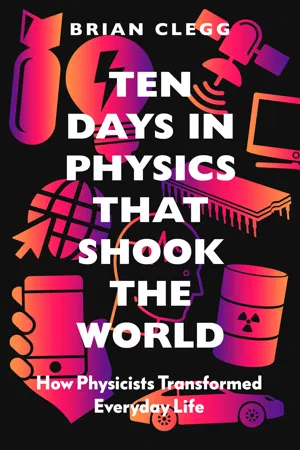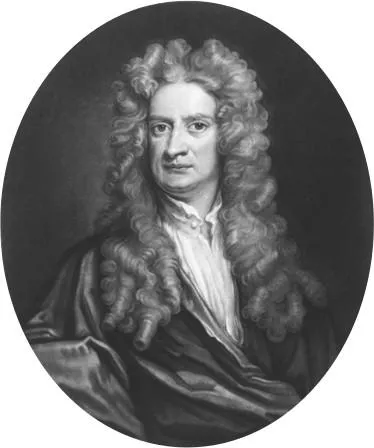DAY 1
Tuesday, 5 July 1687
Isaac Newton – Publication of the Principia
When Newton’s crowning glory, the Philosophiae Naturalis Principia Mathematica (Mathematical Principles of Natural Philosophy) – generally known as the Principia to make it less of a mouthful – was published, physics in the modern sense, making use of mathematics, was born. Featuring Newton’s three laws of motion and his law of gravitation, and developed using his new and essential mathematical tool of calculus, the Principia set in place the mechanical principles linking forces to movement that would enable the industrial revolution to flourish, established the laws that underpin the working of jet engines and aircraft wings, and supplied the gravitational calculations needed to give us the satellites that provide everything from weather forecasts to GPS.
What makes the publication of a book world-changing? It might be at the core of a world religion or a political movement. It could be read by many millions of people and change their lives. It could be responsible for a fundamental change to society. But Isaac Newton’s masterpiece fulfils none of these functions. Instead, it changed the understanding of the universe and how it works for a 2 relatively small audience, who then spread the benefits of that understanding to the rest of us.
Interestingly, the Principia has something in common with novels that regularly make the ‘greatest book of all time’ lists – books like Proust’s À la Recherche du Temps Perdu and James Joyce’s Ulysses. Like them, this is a book that is widely acknowledged as being brilliant, but that very few people in recent years have managed to read (even among those of us who have attempted to do so). Yet, without doubt, this wordy Latin tome, loaded with obscure geometry, has had far greater impact than any literary masterpiece.
The year 1687
A notably uneventful year. Beyond the handful of localised European wars typical of the period, 1687 is unusual in being totally dominated by a single scientific event: the publication of Newton’s Principia.
Newton in a nutshell
Physicist, mathematician, alchemist, heretical religious scholar, MP and bureaucrat
Legacy: Newtonian reflecting telescope, colour theory of light, laws of motion, law of universal gravitation, calculus (method of fluxions)
Born 25 December 1642 at Woolsthorpe Manor, Lincolnshire
Educated: Trinity College, Cambridge
Fellow of Trinity College, Cambridge, 1667–1696
Elected Fellow of the Royal Society, 1672
MP for Cambridge, 1689–1690 and 1701–1702
Warden of the Royal Mint, 1696–1699 3
Master of the Royal Mint, 1699–1725
President of the Royal Society, 1703–1727
Knighted by Queen Anne, 1705
Died 20 March 1727 at home in Kensington, London, England, aged 84
A new view of the universe
This is the story of a book that had a three-year genesis. Yet the history of the components that came together to make that book happen stretches back around 2,000 years. The first essential that led up to the production of the Principia was the developing understanding of the nature of moving objects and gravity. The second was the involvement of one remarkable man.
The physics of motion and gravitation that mostly held from ancient times through to the 17th century was built on two reasonably logical, yet incorrect beliefs. One was that an object had to be pushed if it was to be kept moving. This was apparent by observing most everyday objects. As soon as you stop pushing a cart it starts to slow down and soon it will come to a halt. An arrow that travels two hundred yards before hitting its target will arrive with noticeably less impact than one fired at point-blank range. There was, of course, one example of movement that did seem to carry on indefinitely – the motion of the planets and stars in the sky. But even this was thought to require pushing, usually as a result of divine intervention.
As far as gravity went, the accepted theory was tied into an impressively holistic picture of the universe that took in the nature of the physical elements. There were thought to be four elements that made up everything that existed below the orbit of the Moon: earth, water, air and fire. Two of these (earth and water) had a 4 natural tendency to head for the centre of the universe, the other two had a tendency to move away from the centre. This was not a case of having a force applied to them – a natural tendency was more like a dog’s natural tendency to dislike cats, an inherent part of its nature.
The tendency of earth and water towards the universal centre was described as gravity and the tendency of air and fire away from the centre was known as levity. This, incidentally, was a major underpinning of the Earth-centred view of the universe. The resistance to accepting the Sun-centred view is often portrayed as nothing more than religious obstinacy, but in fact having the Earth at the centre of everything underpinned the physics of the time, which predated Christianity and Islam. And it is anything but obvious that the heavens move because the Earth is rotating – it’s easy to be critical in hindsight, but we still talk of the Sun rising and setting as if the Earth were fixed in place.
The Ancient Greek physics that lay behind this thinking had started to be questioned in medieval times by both Arabic scholars and some of the European universities, though others remained staunch in their support of the familiar old models. However, by the mid-16th century, Copernicus had argued strongly for a Sun-centred universe. This simplified the old model, which had required the fiddly invocation of epicycles, spheres within spheres, to explain the odd movement of the planets in the sky as some reverse their apparent motion because of the interaction between their orbit and that of the Earth.
This approach had been famously supported by Galileo, whose unsubtle presentation of the Copernican view in a book that appeared to mock the Pope led to his trial. However, it should be emphasised that the Copernican model wasn’t the only game in 5 town. Adopting this system implied the need to rewrite all of physics. But in the late 16th century, the great Danish astronomer Tycho Brahe had proposed a system that did away with the problematic epicycles, but still kept the Earth at the centre of things.
In what’s known as the Tychonic model, the Sun, Moon and stars rotate around the Earth, but the other planets are centred on the Sun. In effect this is an accurate model of what really happens, given our viewpoint on the surface of the Earth. In the end it’s a matter of where we look from (frame of reference, as physicists call it) – and at the time, the only place we had was the surface of the Earth. If you take that viewpoint, Brahe was right. It all works, but does not require a change of the fundamentals of physics.
However, Galileo did more than argue for a Sun-centred universe. It’s odd in a way that we remember him for this, the work of Copernicus, and for inventing the telescope – which he didn’t do as there were several earlier telescope makers. Galileo’s great contribution was in reality a book he wrote after his trial while on house arrest. In Discorsi e Dimostrazioni Matematiche Intorno a Due Nuove Scienze (Discourses and Mathematical Demonstrations Relating to Two New Sciences) Galileo began to explore movement in the form of pendulums and balls rolled down slopes, performing experiments that ate away at the classical view of physics.
When Galileo rolled a ball down a slope, it accelerated. When he rolled it up a slope, it slowed down. It was reasonable to assume, with nothing else slowing it down, such as friction and air resistance, that a ball rolling on the flat would continue at the same speed. Just as the Copernican model required a move away from the old element-based view of gravity and levity, so this kind of exploration of the physics of motion undermined the classical idea that a push was required to keep things moving. 6
The Lincolnshire wonder
This was the scientific world – one where the old certainties were increasingly being questioned – into which Isaac Newton was born on 25 December 1642 in the Lincolnshire farmhouse known as Woolsthorpe Manor, into what could only reasonably be described as a troubled family.
7 Newton’s upbringing was difficult. His father died before he was born and his mother, Hannah, remarried a local rector when Newton was three, abandoning the boy to her parents so she could live with her new husband’s family. We know that Newton suffered: in one of his notebooks, among his listed ‘transgressions’ were ‘Threatening my father and mother Smith to burn them and the house over them’ and ‘Wishing death and hoping it to some’.
Although Hannah came back to Woolsthorpe after her second husband’s death when Newton was eleven, the boy was soon parcelled off to school in Grantham, boarding with the family of Mr Clark, an apothecary in the town. Newton seems to have been initially disliked at school, but his practical skill at building mechanical models brought at least a degree of acceptance, even if he was never popular.
Trouble with Newton’s mother would continue, as she removed him from school to work on the farm. Newton regularly sought out opportunities to escape farm work and read; eventually, no doubt frustrated, his mother was persuaded to let him return to school when the headmaster excused Newton the 40-shilling fee usually charged to boys who came from outside the town. However, she would not support him when he went up to Cambridge, requiring him to take a position as a sizar where his keep was supported by acting as a servant to other students.
Cambridge and the Royal Society
Being a student at Cambridge required a profession of the Anglican faith in this period. We are used now to many scientists being atheists, but in Newton’s day, Christianity was an expected part of life in Britain and totally integrated into the thinking of European scientists. Newton was a devout Christian, but his beliefs started out 8 with a more puritanical flavour of Christianity than was common in the Church of England, and he would develop beliefs that were considered outright heresy by the standards of the day. It was also the norm that university fellows had to be single (this, at least, was not a problem for Newton) and ordained in the church – Newton obtained special dispensation from the King to avoid the latter requirement.
Over time, Newton’s beliefs strayed into Arianism. This was a doctrine originated by a 3rd-century Libyan priest named Arius, which rejected the conventional Christian concept of the Trinity and believed that Jesus was created by God, rather than existing from the beginning. Although there had been Arian churches historically, this was an unusual belief in Newton’s day, which he combined with an obsession with finding arcane meaning in ancient texts, culminating in the belief that the date of the end of the world would be no earlier than 2060, obscurely deduced from prophesies in the Bible books of Daniel and Revelation.
Newton’s non-conformist attitude to his religion was of a piece with the approach he took to science. At the time, the curriculum at Cambridge was primarily based on classical sources with litt...

